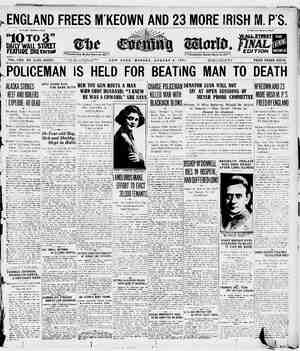The Nonpartisan Leader Newspaper, August 8, 1921, Page 4
You have reached the hourly page view limit. Unlock higher limit to our entire archive!
Subscribers enjoy higher page view limit, downloads, and exclusive features.
S e \ : : ‘ > Z 4 ————————————————— /Do, —Drawn expressly for the Leader by W. C. Morris. Some Facts on Farming Today From Official Sources agriculture for July 13 reports that it costs the farmer $1.18 to raise a bushel of potatoes. This is the average for 461 farms in Wisconsin. If you exclude taxes, charge for the use of land and other overhead expenses, and include only the cost of man and horse labor, manure and seed, the cost to the farmer per bushel is 91 cents. The Monthly Crop Report of the same department for July shows that the country price of potatoes to farmers is a trifle less than 70 cents per bushel. “Problem: How many bushels of potatoes would a farmer have to raise in order to go broke? * * c %k * * THE federal reserve banking system now holds one billion THE Weekly News Letter of the United States department of cash in excess of legal requirements to protect loans, depos- its and currency issues. This is the greatest excess over legal requirements in the history of the reserve system. Contraction of loans, chiefly farmers’ loans, through the deflation policy of the banks, and importation of gold has built up this record excess of cash over legal requirements. According to the Wall Street Journal the federal reserve system, on this basis, could now issue new cred- its to agriculture and business totaling 20 billion of dollars. Yet it is harder now for the farmer to get even a small loan than it has been for many, many years. - 1 %k * * * * : CCORDING to the federal census for 1920 there were in the A United States in that year 300,000 less farms free from mort- gage than there were 10 years ago at the last previous cen- sus. While the value of farms in the United States was increasing during the last 10 years 117 per cent, the total value of mortgages was increasing 132 per cent. : * * * ko ¥k CCORDING to James A. Campbell, president of the Youngs- town (Ohio) Sheet & Tube company, the increase in freight rates over what was paid by farmers last year on a gang plow costing $125, is $28.50. This extra $28.50 that the farmer is now obliged to pay over last year to get such a plow is arrived at ginning right now? Read Mr. Lord’s article on the opposite page. Read the editorial on page 3. Are you ready to ficht? Can we count on you to help in a whirlwind educational and organization campaign be- We know that they have stripped you of about all you have. But unless we have greatly misunderstood the American farmer they haven’t broken your spirit and you won’t . tamely submit. You are down but not out and want to be up and fighting. The Nonpartisan Leader and the Nonpartisan league are going to give you a chance. - The Leader wants to hear from you. We want the advice and help and suggestions of every reader: Shall we go? Shall | we put new “pep” and vigor into the League and get ready for the fight of our lives in the ; political campaign next year? Write us a letter today. Tell us what you think about it by computing the excess freight under the Esch-Cummins law that the farmer is obliged to pay on products he ships to get the money to buy the plow, by figuring the excess freight that the plow factory has to pay in assembling materials, which the company adds to the cost of the plow, and the increased freight on the finished plow it- self when it is shipped-from factory to farmer. President Harding said the. Esch-Cummins act was a great piece of constructive leg- islation. s * % * * * o i HE Wall Street Journal, issue of July 18, quotes what it says are official expert figures to show that the exportation of wheat and corn to foreign countries from the United States - is greater this year than in 1918, 1919 and 1920. Wheat exported last year, 198,108,000 bushels; this year, 333,996,000 bushels. Yet with nearly 100 per cent better foreign market this year than last and less grain to sell, wheat and corn prices are away under what they were last year. * * * * ECENTLY, says United States Senator Ladd, a Maryland R gardener called upon a groceryman to sell some cabbages of excellent quality and wanted 214 cents per pound delivered at the store. The groceryman refused to buy at that price. The same day he was retailing like cabbages at 6 cents per pound. * * * * * F THE farmer pdys the freight he may receive for a 60-pound N . cowhide $2. Any one can figure it out that this hide will make 40 pounds of leather, and the farmer must pay $1.50 per pound to purchase leather with which to resole his shoes. > * * * * * MICHIGAN apple grower employed men to carefully pick, sort and pack apples in new barrels and boxes for the Chi- cago market, says a news dispatch.” When delivered in Chi- cago the farmer received 50 cents per bushel ; not enough to pay-for harvest, labor, containers and transportation charges. - On the same street like apples were retailing at $4 per bushel. L ]








